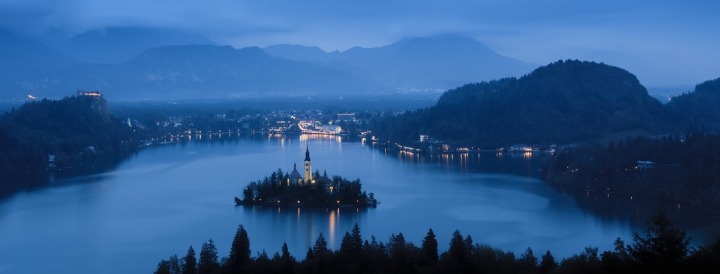2025 Slovenia Visitors Guide
The northernmost republic of what was once Yugoslavia, Slovenia currently appears the most stable, prosperous and welcoming of all Europe’s erstwhile communist countries. It was always the richest and most westernized of the Yugoslav federation, and apart from the Ten-Day War which brought it independence in 1991, it has avoided the strife which has plagued the republics to the south. For centuries, Slovenia was administered by German-speaking overlords and was, until 1918, part of the Austro-Hungarian empire. The Slovenes absorbed the culture of their captors during this period while managing to retain a strong sense of ethnic identity through the Slav-rooted Slovene language, a close relation of Czech, Serbo-Croat, and Slovak.
Slovenia’s landscape is as varied as it is beautiful: along the Austrian border the Julian Alps provide stunning mountain scenery, most accessibly at Lake Bled and Lake Bohinj ; further south, the brittle karst scenery is riddled with spectacular caves like those at Postojna. Slovenia’s capital, Ljubljana , is easily the best of the cities, a vital, youthful place, manageably small and cluttered with Baroque and Habsburg buildings, while the short stretch of Slovenian coast, along the northern edge of the Istrian peninsula, is punctuated by a couple of towns that were among the most attractive resorts of the former Yugoslavia – Piran and Portoroz – not to mention the port of Koper , with its appealingly ancient center. Despite its relative isolation in the eastern part of the country, the attractively preserved town of Ptuj is also well worth a visit.
Opening Hours & Holidays
Most shops open Mon-Fri 8am-7pm and Sat 8am-1pm, with an increasing number opening up on Sundays. Some shops outside major centers may take lengthy lunch breaks. Museum times differ from place to place, but they’re usually closed on Mondays.
All shops and banks will be closed on the following public holidays : Jan 1 and 2; Feb 8 (Day of Slovene Culture); Easter Monday; April 27 (Resistance Day); May 1 and 2; June 25 (Day of Slovene Statehood); Aug 15 (Assumption); Oct 31 (Reformation Day); Nov 1 (All Saints’); and Dec 25 & 26.
Top Attractions in Slovenia
Slovenska Castle
The tower of Slovenska Castle offers a splendid view across Ljubljana – the best time to climb up there is at sunset, when the haze over the plains burns red and gold, suffusing the town in a luxurious light.
Triglav
The ascent (and descent) of Slovenia’s tallest mountain, Triglav (2864m), is just about possible in a day from the Valley of the Seven Lakes. At the top, you can indulge in the age-old tradition of whacking each other on the bottom with a birch stick.
Ljubljana’s Architectural Museum
Ljubljana’s Architectural Museum is housed in the former home of Joze Plecnik, the architect responsible for much of the present-day city, and something of a guru to today’s postmodernist students.
Bled
Bled is the perfect, affordable alpine resort: it has a placid mirror lake, fed by warm water springs, a romantic island you can row out to, a fairy-tale castle high on a bluff, and a backdrop of snow-tipped mountains.
The Kurenti Procession at Ptuj
At Shrovetide, Ptuj is the place to catch a glimpse of the Kurenti processions, a sort of ancient pre-Christian fertility rite and celebration of the dead confused together, once widespread in Europe’s farming communities.
Koper
Arriving from Italy, Koper (Capodistria to the Italians) is the first town you reach. Once you’ve made it past the tower blocks of the modern section of the port, you’ll find a wonderfully rickety old Venetian town, crowded with a dense lattice of narrow streets.
